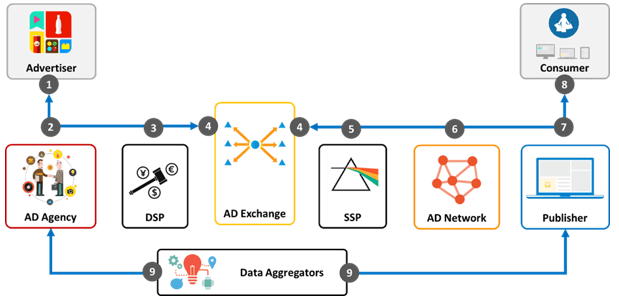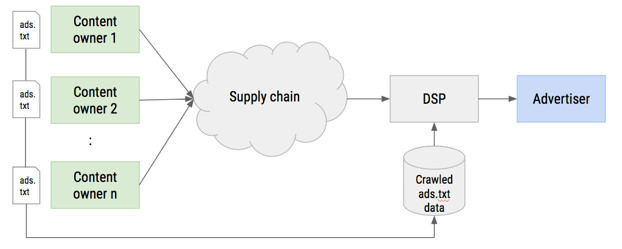In recent years, programmatic advertising has become very popular in the online marketing world. Reason? Automating advertising sales offers efficient opportunities for marketing messages to individuals on a large scale. Unfortunately, a piece of human control has also been lost to automation.
You no longer contact the seller directly to purchase advertising space. Moreover, this has led to advanced trading methods in ad space, where the same ad position is bought and sold multiple times. The consequences? A totally dark ad ecosystem. Moreover, an obscure world is where malicious people are only too happy to commit fraud with advertisements.
What is It?
Programmatic advertising has revolutionized the way digital advertising is bought and sold. It is an automated process that uses algorithms to buy and sell ad space in real-time auctions. This process eliminates the need for human intervention and allows for more efficient and effective ad placements. However, with the rise of programmatic advertising comes the issue of ad fraud. This is where ads.txt comes in.

Ads.txt, short for Authorized Digital Sellers, is a text file that lists all authorized digital sellers for a website. It was created by the International Advertising Bureau Tech Lab in 2017 to combat ad fraud and increase transparency in the programmatic advertising ecosystem. The main purpose of ads.txt is to make the supply chain of online advertising clearer and more transparent and to make things more complicated for fraudsters looking to sell illegitimate ad space.
By listing their authorized sellers, publishers can prevent unauthorized reselling of their ad inventory, which is a common form of ad fraud.
The implementation of ads.txt has positively impacted the programmatic advertising industry. It has helped keep bad actors off the scene and prevent fraudulent selling of a publisher’s inventory. Ads.txt has cultivated a transparent ecosystem that benefits both publishers and advertisers. It has also helped to increase the accountability of all parties involved in programmatic advertising.
Overall, ads.txt has become an essential tool for preventing ad fraud and improving the transparency of programmatic advertising.
Increase transparency
Ads.txt, an initiative of IAB Tech Lab that was rolled out in May 2017, should increase transparency within programmatic advertising and give publishers more control over their inventory, to prevent advertising fraud. However, what exactly does ads.txt mean for the online marketer? You read it in this article.
In order to be able to understand the ads.txt standard and why it was developed, I first go more in-depth into how programmatic advertising works and what all that involves. I conclude with an example of how this process can be misused to commit fraud. I discussed two practices in the programmatic advertising world that emphasize why ads.txt is so essential. Furthermore, I will show, using an example, how ads.txt will lead to more transparency in the programmatic advertising world.
Programmatic advertising: summary
Programmatic advertising is, in short, the automated purchase of advertising space. It is a complicated process in which different actions are carried out within milliseconds. This process can best be explained by a visual.

As you can see, nine components play a role in a programmatic advertising process.
If a visitor (8) reaches a website (7), the owner of this website (the publisher) can offer advertising space via an advertising network (6), a party that brings supply and demand together (think of Google and Facebook for example) ). The publisher can manage the available advertising space via a Supply Side Platform (SSP) (5) and thus also set the price at which space is available.
On the other side of the process, we have an advertiser (1), or the end customer for whom it is advertised. The advertiser often uses an ad agency or media agency (2) to purchase advertising space. This can be done by using a Demand Side Platform (DSP) (3), to book the campaigns with the desired duration, bids, et cetera. The supply and demand side then converge in an auction (4). This auction determines which party has offered the most and won the advertising space.
In addition to this whole process, there are also parties that only collect data (9), in order to subsequently sell this data again. These are, for example, companies that collect data from forums on a large scale (users) and combine this with other (public) data, so that advertisers can target certain profiles (for example man, 20-45, highly educated and in possession of a car).
How it can go wrong?
Due to the complexity of programmatic advertising, it is unclear what role each party has (or may have). This, therefore, offers malicious people room to commit advertising fraud. An example: the Financial Times (ft.com). The Financial Times sells advertising space through two auctions: Google AdX and TrustX. Fraudsters made it appear that ft.com was active on about twenty ad auctions. Even at sales where advertising space for videos was sold, although ft.com does not have advertising space for videos. Ft.com estimates the financial damage of these practices at 1.3 million dollars a month (!).
What is ads.txt and why is it necessary?
The example of the Financial Times above shows that it is important to increase transparency in programmatic advertising. The ads.txt standard has been developed with this in mind. In ‘ads.txt’, ‘ads’ stands for ‘Authorized Digital Sellers’. Ads.txt makes it possible, using a publicly accessible file, to indicate via which account the publisher advertises space directly, and through which organizations/auctions the advertising space is auctioned.
Understanding ads.txt and its implementation
Ads.txt, or Authorized Digital Sellers, is a simple, flexible, and secure method for publishers and distributors to declare who is authorized to sell their inventory. The goal of ads.txt is to combat ad fraud and increase transparency in the programmatic ecosystem.
By including authorized vendors in an ads.txt file, publishers can ensure that programmatic buyers are sourcing inventory directly from them or authorized resellers. This helps reduce ad fraud by verifying the legitimacy of ad inventory, allowing advertisers to buy inventory with confidence and eliminating the risk of buying fraudulent or counterfeit inventory. Ads.txt was launched in 2017 to protect ad inventory and prevent programmatic ad fraud.
Ads.txt serves as a public directory of authorized digital sellers that programmatic buyers can refer to when purchasing inventory from a publisher. The file is updated regularly to remain current and accurate, which helps reduce the risk of programmatic ad fraud.
Using ads.txt and app-ads.txt along with other available fraud prevention tools to verify the validity of programmatic deals is a must for all media owners.
The implementation of ads.txt in programmatic advertising involves a few simple steps. First, publishers must create an ads.txt file and upload it to their domain’s root directory. The file should contain a list of authorized digital sellers, including their domain name, seller account ID, and relationship type.
Once the file is uploaded, publishers must notify their programmatic partners and encourage them to crawl the file to ensure that they are authorized to sell the publisher’s inventory. By implementing ads.txt, publishers can protect their inventory and prevent ad fraud while increasing transparency and trust in the programmatic advertising ecosystem.
Domain spoofing
The necessity of this standard stems from various practices in the programmatic advertising world, including the spoofing of domains, such as the example of the Financial Times. When spoofing a domain, a fraudster makes it appear as if a random domain is a premium placement. The aim of this is, of course, to earn advertising spend. Advertisers think their ads are displayed on a major publisher website, while in reality, it is on an unwanted website (certain forums, torrent websites, etc.).
Two ways of domain spoofing
Domain spoofing can take place in two ways. The first way is to hijack a user’s browser and enter a piece of code that displays advertisements in this browser. So these ads appear instead of the ads from the publishers themselves.
The second method uses the way publishers send information when calling an ad auction. This is because information is provided to the advertiser utilizing a piece of code (on which website a user is located and on which a bid can be made). This piece of code can be modified by malicious parties to send false information to the ad auction. This way it can be done as if an impression is being auctioned off a premium placement, whereas in reality, this is not the case.
An example of domain spoofing is the Financial Times that was described above.
Domain arbitration
Another reason why the ads.txt standard has been developed is that in the programmatic advertising world the buying and selling of advertising spaces also take place by intermediary parties. This is called domain arbitrage. Domain arbitration is applicable as an intermediary, for example an advertising network where demand (advertisers) and supply (publishers) meet, bulk advertising space can buy up with publishers and with that discount terms, but then this ad space can sell more expensive.
How does ads.txt provide more transparency?
Ads.txt increases transparency by making it clear in a publicly accessible text file via which system a publisher sells advertising space and who can resell it via which networks. Once the publisher has implemented ads.txt, anyone can view this file by placing “/ads.txt” behind the domain. So if you want to see ads.txt from toptut.com, then go to toptut.com/ads.txt in your browser. An example snippet of an ads.txt file:

From the above, the following can be read:
www.toptut.com sells advertising space through various seller accounts. Each line is a separate seller account. Within each line four fields are indicating:
First the domain of the authorized party that can sell advertising space from toptut.com. In this case, that is Google.com.
This party has an associated account ID in the second field.
The third field indicates whether the publisher manages the account (directly) or has it managed via a third party (reseller). In the above example, toptut.com is directly connected to the buttons.
The last field is optional and can be used to provide an ID with which the authorized vendor can be identified with a certification authority such as TAG.
The visual below shows a different situation. A website sells advertising space through three different seller accounts and three different networks. The DSP that an advertiser uses can automatically call the ads.txt files to determine which vendor accounts and ad networks the ad slots are sold on. The advertiser knows which domains, ad networks, and seller accounts are authentic.

What is the status of Ads.txt?
The ads.txt standard is slowly becoming established. In November 2017, for example, almost half of the 10,000 top domains had implemented ads.txt. This increase was partly due to the acceptance of this standard by Google. At the end of 2017, Google indicated that DoubleClick Bid Manager (DBM), AdSense and DoubleClick Campaign Manager (DCM) would support this standard.
Meanwhile, more than 20 percent (16-01-2018) of the top 5,000 Alexa websites use ads.txt. This standard also seems to be well-received in the Netherlands. A sample of some large Dutch publishers shows that the majority have implemented ads.txt.
Restrictions on Ads.txt
Although the ads.txt standard is a good step towards more transparency in the programmatic advertising world, this standard still has limitations. The standard has been developed for the web and is therefore not usable for mobile apps, for example.
Furthermore, transparency about which parties are authorized vendors is not equal to eliminating advertising fraud. After all, an authorized vendor can mix bot traffic (artificial computer traffic instead of traffic between real people) with authentic traffic.
Another limitation of ads.txt is that DSPs and publishers must implement ads.txt before it affects anything. Otherwise, it is still possible for fraudsters to continue the practices discussed earlier. The last bone network identified by Adform (pdf) also indicates this.
Benefits of using ads.txt in Programmatic Advertising
Ads.txt, or Authorized Digital Sellers, is a text file designed to increase transparency and accountability in the programmatic advertising ecosystem. By listing authorized sellers of a publisher’s digital inventory, ads.txt helps make the supply chain of online advertising clearer and more transparent. This improved transparency and accountability benefits publishers and advertisers by enabling them to identify and verify legitimate ad inventory sources easily.
One of the most significant benefits of using ads.txt is its ability to reduce the risk of ad fraud. By white-listing authorized sellers, ads.txt makes it more difficult for malicious actors to sell fake ad inventory, reducing the likelihood of domain spoofing and fake ad requests. This reduction in ad fraud helps protect the interests of both publishers and advertisers and increases confidence in the programmatic advertising ecosystem.
By increasing transparency, preventing ad fraud, and improving ad revenue, ads.txt is helping to build a more efficient, effective, and trustworthy digital advertising industry.
Ads.txt has already significantly impacted the industry, bringing greater transparency and helping to keep bad actors out of the programmatic scene. Using ads.txt with other anti-fraud tools is a must for all media owners looking to prevent ad fraud and increase trust and confidence in programmatic advertising.
A step forward…
Unfortunately, given the previously discussed limitations, the ads.txt standard is not a complete solution, but it is a step forward. Increasing transparency makes it much more difficult to carry out domain arbitration and other unwanted practices. This makes this type of practice much less profitable and therefore less attractive.
Advertisers, agencies, and publishers must be aware of the ads.txt standard, but especially of the reason why the standard was created. Through awareness, I hope that a requirement will arise to support ads.txt. Advertisers will have to urge agencies to take all possible measures so that their advertisements are displayed on authentic domains. At the same time, agencies will have to push DSPs to support and use the ads.txt standard. Publishers will, in turn, have to support the ads.txt standard as an additional quality characteristic of their inventory.

